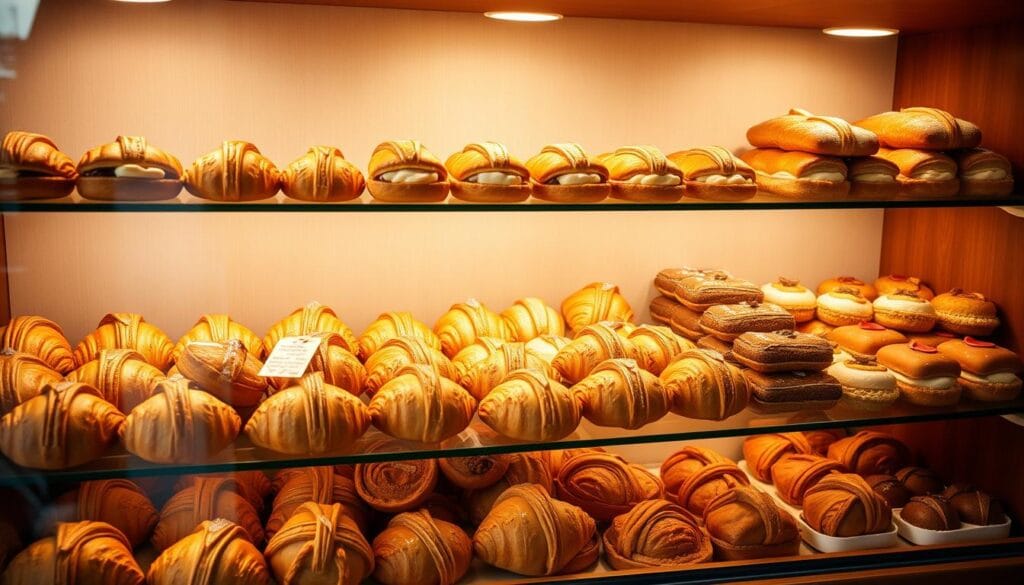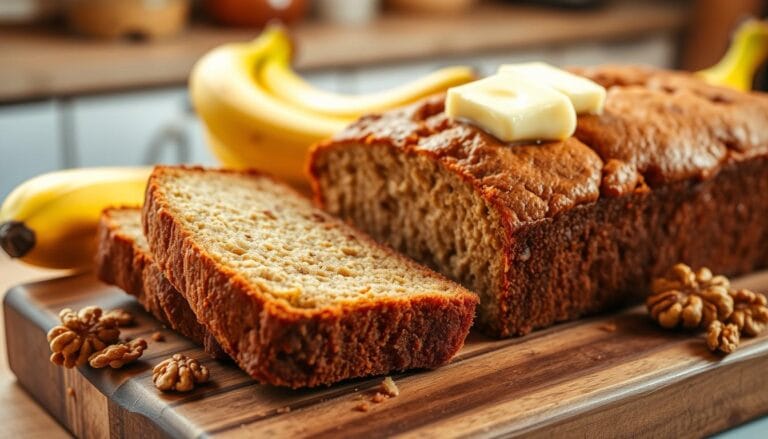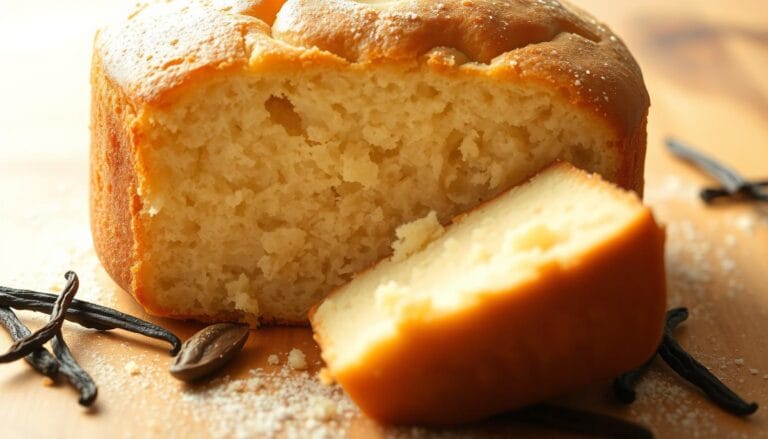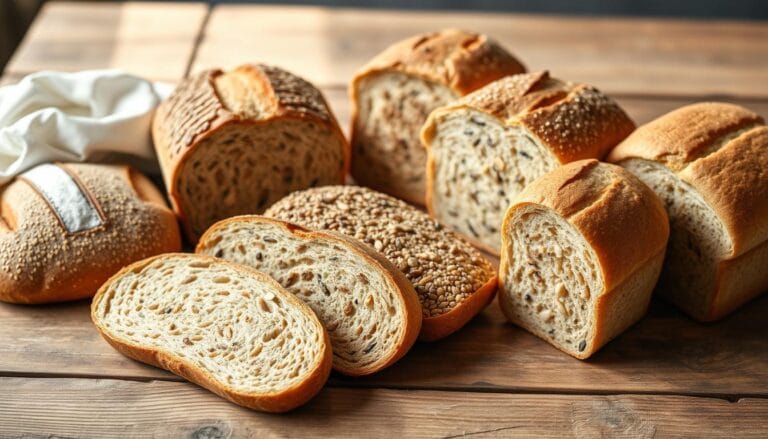Croissant Bread: 5 Irresistible Ways to Enjoy It
Imagine waking up to the smell of freshly baked croissant bread. It has a flaky pastry and a golden crust. You can make this by baking croissant bread from scratch. This way, you control the ingredients and enjoy a delicious bakery fresh croissants experience.
Table of Contents
Starting this baking journey brings joy. You’ll make a delicious and flaky croissant bread. With ingredients like all-purpose flour, warm milk, and softened butter, your bread will be tasty and look great. Whether you’re new to baking or experienced, making croissant bread is rewarding. It lets you improve your baking skills and share a tasty treat with your loved ones.
The Art and History of Croissant Bread
Croissant bread has a rich history from France, known for its flaky and buttery bread texture. Its origins are tied to Austria, where the kipferl pastry was born in the 13th century. The kipferl made its way to France in the 17th century, evolving into the croissant we love today.
The croissant has become a key part of French baking. Its homemade croissant recipe has been passed down for generations. Making croissants involves a special technique called lamination. This method creates layers of dough and butter, giving the croissant its flaky and buttery taste.
Today, croissants come in many flavors, like chocolate and nuts. These gourmet breakfast pastries are a hit with food lovers. The croissant’s rich history and versatility make it a favorite pastry globally.
Here is a brief overview of the nutritional values of a typical croissant:
| Nutrient | Value |
|---|---|
| Calories | 300 kcal |
| Total Fat | 17 g |
| Saturated Fat | 10 g |
| Cholesterol | 45 mg |
Essential Ingredients for Perfect Croissant Bread
To make a delicious french pastry like an artisanal croissant, you need the right ingredients. You’ll need high-quality flour, yeast, salt, sugar, and butter. These will help you make delicious baked goods that are light, flaky, and full of flavor.
When picking your ingredients, choose the best ones. Using European-style butter will make your croissants taste richer. Also, all-purpose flour is key for a smooth dough.
Here are the main ingredients you’ll need:
* 4 cups of all-purpose flour
* 1 tablespoon of active dry yeast
* 2 1/2 teaspoons of fine sea salt
* 1/4 cup of granulated sugar
* 1 1/2 cups of cold unsalted butter
With these ingredients and a traditional recipe, you can make delicious baked goods. Whether it’s french pastry or artisanal croissant, the right ingredients are crucial for quality and flavor.
Tools and Equipment You’ll Need
To make tasty croissant bread with a flaky pastry texture, you need the right tools. Having the right items will help you make bakery fresh croissants just like the pros. Experts say you need 25 key pieces, like commercial ovens and mixers, to start a bakery.
A stand mixer is key for mixing and kneading dough. You’ll also need a pastry brush for egg washes and glazes. A baking sheet is crucial for baking croissant bread to a golden brown. You’ll also need baking sheets, pans, cooling racks, and refrigerators for storing ingredients.
Professional bakers use special tools like dough sheeters and display cases. For home bakers, a few key tools can make a big difference. Silicone mats, digital scales, and good mixing bowls are recommended.
With the right tools, you’ll be on your way to making delicious croissant bread. Whether you’re a pro or a home baker, the right equipment ensures perfect croissant bread every time.
Mastering the Lamination Process
To make a tasty homemade croissant recipe, you must get the lamination right. This means making perfect butter layers and folding the dough. The goal is to get a flaky and delicious pastry. The right temperature and humidity are key. The butter should be between 52 to 61°F (11 to 16°C), and the dough cooler, between 36 to 43°F (2 to 6°C).
Here are some tips to help you master the lamination process:
- Use a high butterfat content (82-86%) for optimal lamination
- Maintain the right temperature and humidity levels during proofing
- Use a dough sheeter to ensure consistent thickness and precise layers
- Use a soft-bristled pastry brush to dust off excess flour during lamination
By following these tips and practicing, you can make a flaky buttery bread like those in bakeries. Whether for gourmet breakfast pastries or to impress others, mastering lamination is crucial. With patience and practice, you’ll get perfect lamination and a delicious homemade croissant recipe.
| Temperature | Humidity | Proofing Time |
|---|---|---|
| 75 to 78°F (24 to 26°C) | 60 to 70% | 1 to 2 hours |
Step-by-Step Croissant Bread Recipe
To make a delicious french pastry like artisanal croissant, start by mixing 4 cups of all-purpose flour, 1/3 cup of granulated sugar, and 4 teaspoons of active dry yeast. Add 1 cup of milk, 1/4 cup of unsalted butter, and 1 large egg. Mix well and let it rest for 1 hour.
Roll out the dough to a 15″ x 8″ size and fold it 4 to 6 times. Refrigerate it for 8 hours or overnight. The next day, roll it out again to the same size. Cut it into 4 strips, about 3″ wide and 18″ long. Let it proof for 2 to 3 hours until it’s puffy.
Preheat the oven to 425°F and bake the croissant bread for 15 minutes. Then, reduce the temperature to 375°F and bake for another 10 to 15 minutes. This will ensure the internal temperature reaches 205°F. Let the bread cool for at least 20 minutes before slicing. Your delicious baked goods are now ready to be enjoyed.
To customize your artisanal croissant recipe, try adding different flavors like chocolate or nuts. You can also experiment with different types of milk or butter for a unique taste. With this recipe, you can create a variety of delicious baked goods perfect for any occasion.
Common Mistakes and Troubleshooting Guide
Making croissant bread can be tricky. You might run into common mistakes that affect your pastry’s quality. We’ve put together a list of troubleshooting tips and solutions. These guidelines are for both beginners and experienced bakers, helping you make delicious, bakery fresh croissants.
Common mistakes include overmixing the dough, underbaking, and using low-quality ingredients. These issues can be fixed with a few simple tips. For instance, mix your dough just until it comes together. Also, avoid overbaking your croissant bread.
Here are some additional tips to help you troubleshoot common issues:
- Check your ingredients: Use high-quality ingredients, including fresh yeast and good-quality butter.
- Monitor your temperature: Keep an eye on your oven temperature to ensure it’s at the right level for baking croissant bread.
- Don’t overproof: Make sure you’re not overproofing your dough, as this can cause it to become too puffy and prone to collapse.
By following these tips and being mindful of common mistakes, you can create delicious, flaky croissant bread. Always use high-quality ingredients and follow your recipe carefully for the best results.

With practice and patience, you’ll master making beautiful, bakery fresh croissants. Don’t get discouraged if your first batch isn’t perfect. Just keep trying, and you’ll soon enjoy delicious, homemade croissant bread.
| Mistake | Solution |
|---|---|
| Overmixing the dough | Mix ingredients just until they come together |
| Underbaking the pastry | Check oven temperature and baking time |
| Using low-quality ingredients | Use fresh yeast and good-quality butter |
Creative Variations of Traditional Croissant Bread
Homemade croissant recipes offer endless possibilities. You can mix and match fillings, toppings, and flavors to make gourmet breakfast pastries. Try using whole wheat flour for a nuttier taste. Or, use leftover croissants for dishes like bread pudding or French toast.
Thinking outside the box is key to making unique croissant bread. Try new ingredients and flavors. For example, Gruyere cheese adds a rich taste. Smoked salmon and cream cheese make a fancy breakfast.
Here are some ideas for creative croissant bread variations:
- Use turkey and pesto or ham and cheese as fillings.
- Add fruits like raspberries or blueberries for a sweet touch.
- Try different cheeses, like feta or goat cheese, for unique flavors.
Experimenting with ingredients and flavors leads to delicious, unique pastries. Don’t be afraid to try new things. With practice and patience, you’ll master making creative croissant bread.
Storage and Reheating Tips
To keep your french pastry fresh, proper storage is key. Store artisanal croissant at room temperature for a few days. You can also keep them in the fridge for up to a week. For longer storage, freeze them in a resealable bag.
There are several ways to reheat your delicious baked goods. Here are a few:
- Preheat your toaster oven to 350 degrees Fahrenheit for optimal reheating of croissants.
- Use a conventional oven to reheat room temperature or stale croissants for 5-7 minutes. Frozen croissants need a few extra minutes.
- The air fryer method typically takes about 3 minutes to reheat a croissant effectively.
Reheating methods like the toaster oven or conventional oven work best for stale croissants. When reheating multiple croissants, make sure they’re spaced apart. This allows for even hot air circulation.

By following these tips, you can enjoy your french pastry for longer. Whether it’s a freshly baked artisanal croissant or a reheated one, these tips will enhance your experience. Enjoy your delicious baked goods to the fullest.
Serving Suggestions and Pairings
Your freshly baked croissant bread is perfect for many delicious pairings. It’s great for breakfast, brunch, or a snack. The flaky, buttery texture goes well with both sweet and savory flavors.
Try the classic jam and croissant bread combo. Or, make a ham and cheese croissant bread sandwich for a tasty start. For a bigger meal, fill it with sausage, veggies, or a breakfast scramble.
There are many ways to use croissant bread in your meals. Turn stale croissant bread into a tasty bread pudding. Or, make a French toast casserole with it. Bakery fresh croissants look amazing on a platter with various toppings, perfect for parties or sharing.
Whatever way you serve your flaky pastry, your guests will love it. Homemade croissant bread adds a special touch to any meal. It’s a great way to impress and make memories with your cooking.







